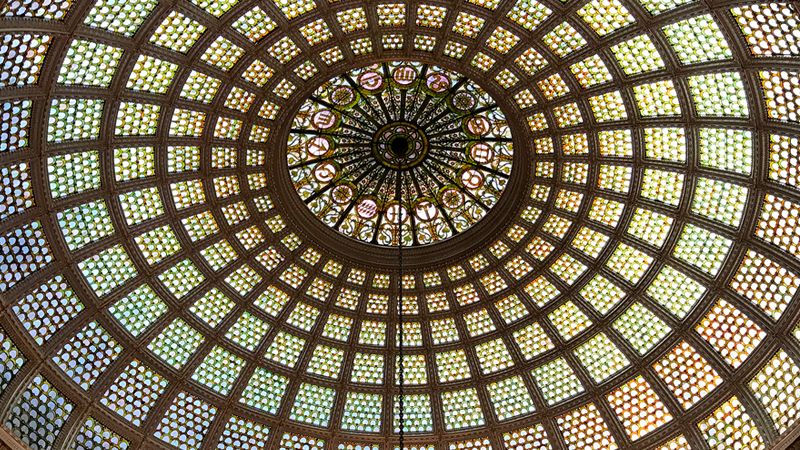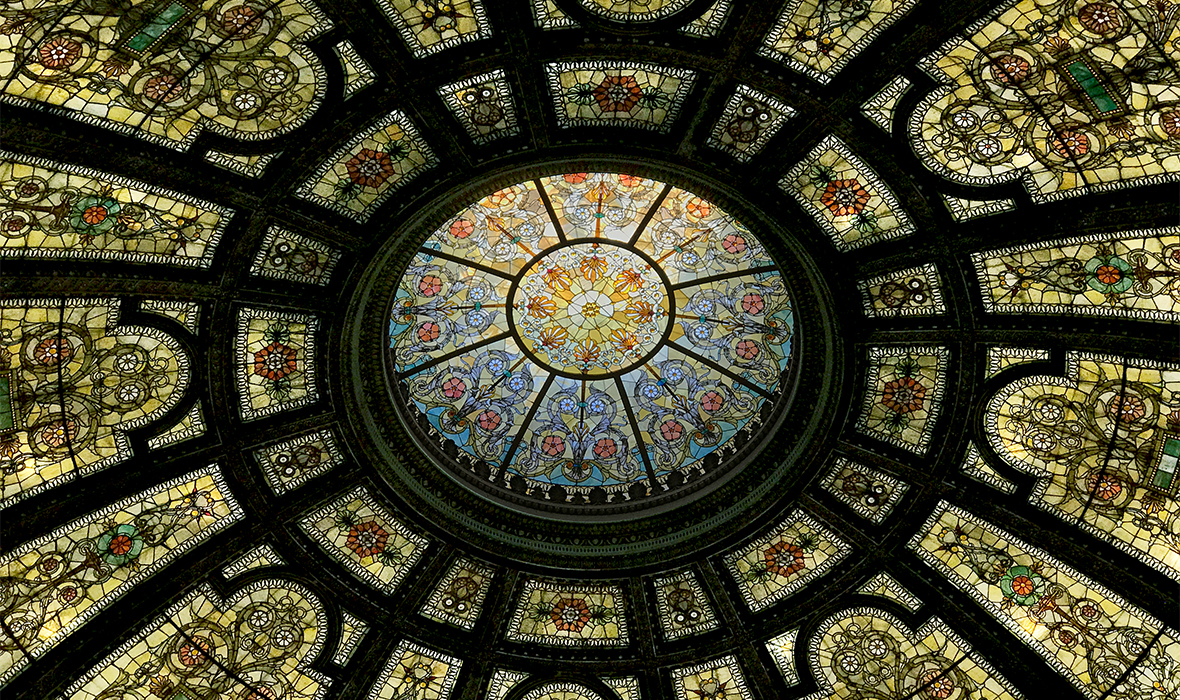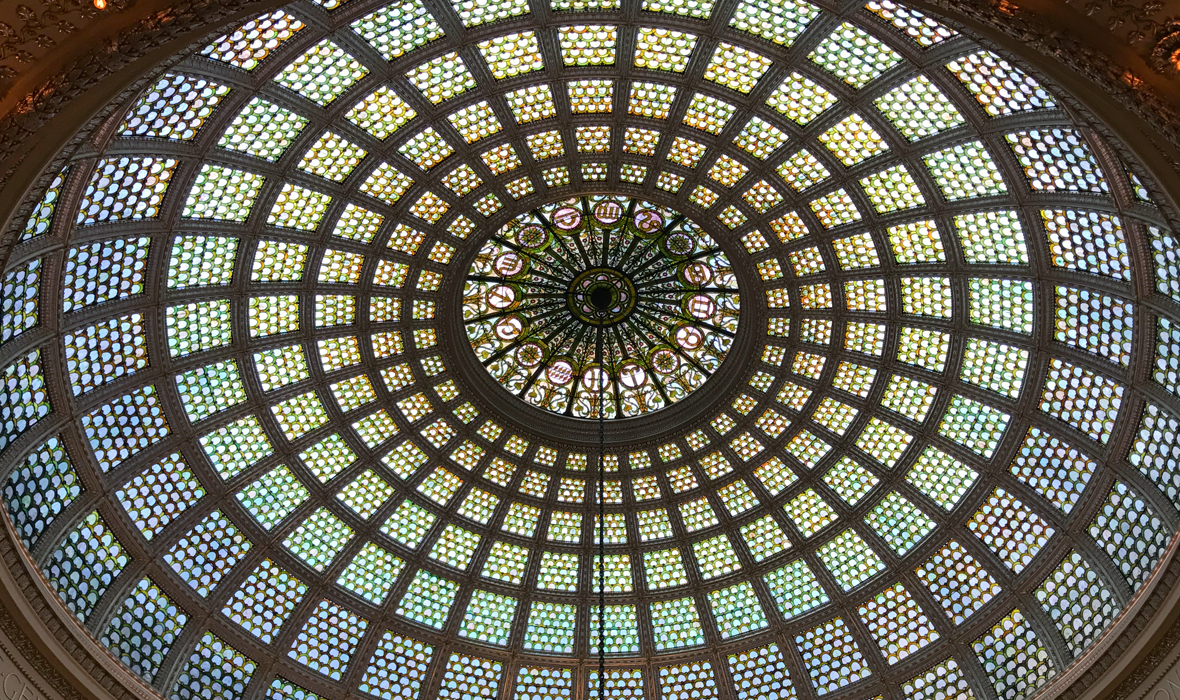
After visiting the Art Institute of Chicago, we had just enough time to take a short walk down the street to the Chicago Cultural Center before we needed to hop the train to Wrigley Field for the final Dead & Company concert of the 2017 summer tour.
Drawn by its beauty and the multitude of free music, dance and theater events, films, lectures, art exhibitions, and family events, hundreds of thousands of visitors come to the Chicago Cultural Center every year. But we were only in Chicago for seven full days, and we were only going to be visiting the center one time.
What caught my attention were the two magnificent stained-glass domes found inside the landmark building. Once I learned that one of the glass domes is the largest Tiffany glass dome in the world, I knew we were going to visit the historic building no matter what.

Chicago Cultural Center History
Completed in 1897 as Chicago’s first central public library, the building was designed to impress and to prove that Chicago had grown into a sophisticated metropolis.
Designed by the Boston firm of Shepley, Rutan & Coolidge, the building’s Beaux Arts style was influenced by the buildings of the 1893 World’s Columbian Exposition. The interior features rooms modeled on the Doge’s Palace in Venice, the Palazzo Vecchio in Florence, and the Acropolis in Athens. The country’s top architects and craftsmen used the most sumptuous materials, such as rare imported marbles, polished brass, fine hardwoods, and mosaics of Favrile glass, mother-of-pearl and colored stone, to create an architectural showplace.
- On the south side of the building in Preston Bradley Hall, is the world’s largest stained glass Tiffany dome, measuring 38 feet in diameter with some 30,000 pieces of glass.
- On the north side of the building, in the Grand Army of the Republic Hall, is a 40-foot-diameter glass dome designed by Healy & Millet, with some 50,000 pieces of glass in an intricate Renaissance pattern.
In 1991, the building was established as the Chicago Cultural Center by the Chicago Department of Cultural Affairs, the nation’s first and most comprehensive free municipal cultural venue. Every year, the Chicago Cultural Center presents hundreds of free international, national, regional, and local artists, musicians, and performers, providing a showcase where the public can enjoy and learn about the arts.
The Chicago Cultural Center building was listed on the National Register of Historic Places on July 31, 1972, and was designated a Chicago Landmark by the City Council on November 15, 1976.

The Tiffany Dome
The magnificent translucent dome, measuring 38 feet in diameter and spanning more than 10,000 square feet, is made of some 30,000 Tiffany Favrile glass pieces in 243 sections held within an ornate cast iron frame. At the top of the dome are the signs of the zodiac. At the base of the dome is a quotation from the British author Joseph Addison.
The dome glass, lighting fixtures, wall sconces and chandeliers were made by the Tiffany Glass and Decorating Company of New York. The supporting frame was constructed by the Chicago Ornamental Iron Company.
The restoration of the Chicago Cultural Center’s Louis Comfort Tiffany art glass dome — the largest Tiffany glass dome in the world — was completed in 2008 with awe-inspiring results. This project restored the dome to Tiffany’s original vision. Now the dome can be seen as it was in 1897, when the building opened as the first Chicago Public Library. Natural light shines through the glass, changing the subtle colors of the restored glass minute-by-minute.
- To restore the glass, the panels were removed from the framework and taken to a world-renowned glass studio where they were disassembled so each piece of glass could be cleaned by hand, repaired as necessary, and reassembled with new leading.
- The concrete and copper exterior dome was removed, and replaced by one that is translucent and energy-efficient. The reintroduction of natural light into Preston Bradley Hall reduces the need for artificial lighting, which reduces electrical costs.
- The cast iron framework was given a new application of its original finish, aluminum leaf. Delicate rosette lighting around the cornice of the dome, which had not been used in decades, also was refurbished, creating an elegant transition between the upper and lower portions of the room.
- The final step was to reinstall the restored glass panels.
Know Before You Go
- The Chicago Cultural Center is located at 78 E. Washington Street, Chicago, Illinois 60602 across the street from the Art Institute of Chicago.
- Hours are Monday through Thursday 9:00 am to 7:00 pm, Friday and Saturday from 9:00 am to 6:00 pm, and Sunday from 10:00 am to 6:00 pm. The center is closed on holidays.
- Free building tours, revealing the storied history of the landmark Chicago Cultural Center, are offered year-round on Wednesdays, Thursdays, Fridays, and Saturdays at 1:15 pm and are 45-60 minutes long. Tours meet in the Randolph Street lobby and are limited to the first 20 people.
- There are several free galleries in the building you can visit, as well as incredible mosaic tile work, and two spectacular glass domes, including the largest Tiffany glass dome in the world.





